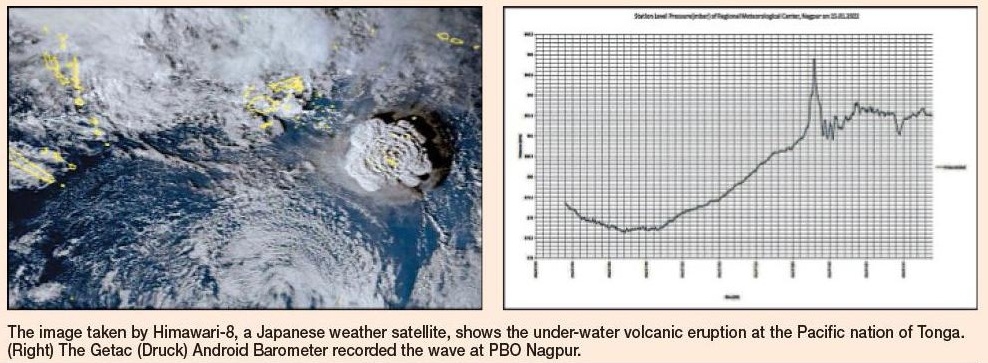City-based observatory records Tonga volcanic eruption wave
| Date :20-Jan-2022 |

By Kaushik Bhattacharya :
The Pilot Balloon Observatory recorded the wave exactly 11 hours and 10 minutes after volcanic eruption in Tonga, 12,386 km away from Nagpur
The wave travelled at a speed of 1,100 km/ph (approx)
The city-based Pilot Balloon Observatory (PBO) of Regional Meteorological Centre (RMC), on Saturday, recorded a wave which was generated after the massive under-water volcanic eruption in Tonga in the Pacific Ocean. The atmospheric pressure was recorded in the city which is located 12,386 km away from the volcanic eruption site in Tonga. The city’s barometer recorded the wave around 8.40 pm on Saturday. Though the wave was felt in many parts of the world, it was a unique event for everyone here, including Weather Department, as it witnessed the event for the first and perhaps the last time. “It was rarest of the rare event that we recorded in our barometer. It is most powerful eruption since 1100 AD,” Milind M Phadke, Meteorologist ‘A’, RMC, Nagpur told ‘The Hitavada’. “It was recorded as a blip in the atmospheric pressure that suddenly spiked by around 1 hectopascals (hPa) around 8.40 pm in city on Saturday, around 11 hours and 10 minutes after the eruption in Tonga,” said the Meteorologist. “A change in amplitude of up to 2.5 mb (at Nagpur 1 mb kink) was noted in the barograph.
Most of the places, the temperature dropped by 1 degree Celsius just 15 minutes before the pressure spike and relative humidity increased by 2% just 10 minutes before the spike,” said Phadke. “A 15 minute pressure altimeter change was also recorded via National Weather Service in a 5 min interval data,” added the meteorologist. The eruption of the underwater volcano, believed to be one of the largest in recent history, took place at 5.15 pm local time on Saturday (10.15 am IST), triggering tsunami varying intensity along the coasts of many countries on the Pacific Ocean. “The sound was heard in some places in New Zealand, located roughly 2,500 km away. While it could not be heard in India, it was recorded as a sharp but minor increase in atmospheric pressure,” said Phadke.
The wave travelled at a speed of around 1,100 kmph to reach the skies of the city 11 hours after the event. Because of the magnitude of the volcanic eruption, which sent plumes several kilometres high in the air, it was felt across the globe. In India, we have one active volcano; it is in Barren Island, East of Port Blair, along the chain of volcanoes from Sumatra to Myanmar. According to United States Geological Survey (USGS), there are about 1,350 potentially active volcanoes worldwide. About 500 of those have erupted, according to data available with USGS. Many of those are located along the Pacific Rim in what is known as the ‘Ring of Fire’. The event was corroborated by renowned Astrophysicist Dr Mukund Moholkar also and according to him Ingress of Sun in Makar Rashi on January 15 and Ingress of Mars on January 16 Dhanu Rashi. Both are violent planets for tsunami and the event took place due to the same. Under the supervision of Phadke, Scientific Assistant (SA) Shreekant Khobragade collected the data of the volcanic eruption and SA Vikash Meena prepared the graphs for this event.